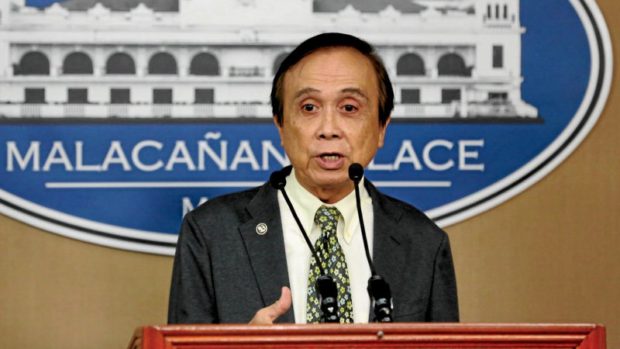
Socioeconomic Planning Secretary Ernesto M. Pernia (File photo by JOAN BONDOC / Philippine Daily Inquirer)
For the country’s chief economist, the record-high trade deficit of $3.781 billion posted in November last year was “not good, but transitory and manageable.”
This was Socioeconomic Planning Secretary Ernesto M. Pernia’s response when asked by the Inquirer about the sustained robust imports growth outpacing that of merchandise exports, which is putting pressure on the peso.
On Wednesday, the Philippine Statistics Authority reported that the value of imported products that entered the country in November jumped 18.5 percent to $8.744 billion from $7.378 billion during the same month in 2016.
Sales of Philippine-made goods abroad likewise increased that month but by a slower 1.6 percent—the lowest rate of increase in a year—to $4.963 billion from $4.887 billion a year ago.
As such, the total external trade in goods rose 11.8 percent to $13.707 billion in November from a year ago’s $12.264 billion.
Since the value of imports outpaced exports, the country’s balance of trade in goods remained at a deficit, the widest on record.
In a note to clients Wednesday, Pauline May Ann E. Revillas of Metropolitan Bank and Trust Co.’s research department said “the expectations of higher imports on the back of the government’s massive infrastructure spending plan this year would still likely weigh on the peso.”
Revillas added that they expect the peso to end 2018 at 51.75:$1 partly as “emerging market currencies remain vulnerable to improving US economic fundamentals and tighter Fed policy.”
Economic managers had said that as the Duterte administration embarks on its ambitious “Build, Build, Build” infrastructure program alongside expectations of sustained strong economic growth, demand for imports would remain robust in the near term.
Under “Build, Build, Build,” the government plans to roll out 75 flagship, “game-changing” projects, with about half targeted to be finished within President Duterte’s term, alongside spending a total of up to P9 trillion on hard and modern infrastructure until 2022 to usher in “the golden age of infrastructure.”
The surge in imports, however, had reversed the current account to a deficit, which had the market worried and pulled the peso weaker in recent months.
A component of the balance of payments, the current account was expected to swing to a $100-million deficit in 2017 from the $600-million surplus in 2016 amid the government’s push to ramp up infrastructure investments leading to a surge in imports of capital goods.
This year, the current account deficit is expected to swell to $700 million.

